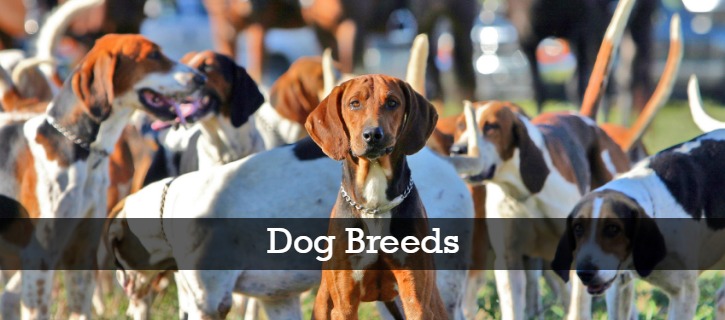The Plott Coon Hound
The Plott coonhound’s bloodline originates in Germany, it is the only coonhound that does not have its roots in English bred hounds, like the other seven coonhound breeds. The Plott coonhound history is better known than the English derived coonhounds.
Five Hanovarian hounds – German-bred brindle and hunting dogs – were brought to America by German immigrant Johannes Plott in 1750, and he settled in the Great Smoky Mountains of western North Carolina and Tennessee. The Hanovarian hounds were hounds bred for stamina, cold-nose and instinct to chase big ferocious game animals, like wild boar and bear, but adapted quickly and also became exceptional hunters of deer, mountain lion, bobcat and raccoon.
It was Johannes Plott’s son, Henry Plott, who continued to breed these Hanovarian hounds after they were given to him by his father. They quickly became known for their incredible skill in tracking and treeing the American black bear and by 1850 were well-known in Northern Carolina and nearby regions as intelligent, versatile and exceptional capable hunting hounds.
Strengths of the Plott Coon Hound
Due to the breeding of the Plott coonhound, it is more of a big game hunter than a coon dog, and is appropriately fearless and aggressive on a hunt. They are particularly committed to each hunt, seemingly unable to feel pain while on the chase and if they have to fight they often will not stop until they are severely injured.
They also develop the typical coonhound ‘selective hearing’ when pursuing quarry, and sing the melodic coonhound song when they have treed an animal, although this is higher pitched that other coonhounds. While the Plott coonhound is still a popular hunting dog, they are also desirable as pets, particularly as they are especially protective of their family and make wonderful watch-dogs.
Potential Problems of Plott Coon Hounds
The Plott coonhound is not as strong-willed or dominant as some of the other coonhound breeds but they do still need consistent leadership, training and extensive exercise and work to prevent boredom and destructive behavior.
They also differ from the other coonhounds while trailing a scent – they have a homing instinct and will not just pursue an animal to the ends of the earth like other coonhounds, often able to find their way back home very quickly.
The Plott coonhound, similar to the other large coonhounds may suffer from hip dysplasia. Particular to Plott coonhound is the tendency toward gastric bloat, therefore feeding small amounts at a time is important – wolfing down a large meal is likely to induce gastric bloat in a prone coonhound.
Other conditions, such as hypothyroidism (an underactive thyroid) and thrombopathia (a platelet disorder) are known to affect these dogs at times. Apart from a few coonhounds that are afflicted, the majority are otherwise healthy, energetic dogs who may live up to 15 years.
This very different colored coonhound is incredibly hard-working, and capable of hunting all but the very largest game, while still being a big gentle family dog that will fit into an active outdoors loving family beautifully.
If the Plott Coonhound isn’t for you, consider one of the other Coon Hound Breeds.









Treeing Walker Coon Hounds
November 27, 2014 by Hunter • Coon Dogs • Tags: hounds • 0 Comments
The treeing Walker coonhound is a beautiful and highly skilled hunting companion.
A Mr. Thomas Walker brought an English foxhound to Virginia in 1742 and it is speculated that the breed has descended from an accidental pairing of a cross-bred hound and one of the later English related Virginia foxhounds.
Treeing Walker coon hounds were finally acknowledged as an official breed in 1945 and while they have retained the rich coloring of the Walker fox hound, their hunting style is now quite different. These dogs will track and chase a raccoon until it runs up a tree, and the loud call of the coonhound alerts his handler that the tracking is over.
Treeing Walker coon hounds are fast and locate their quarry very quickly, but they’ll also chase all day and all night if necessary, such is their endurance and stamina. A raccoon may find itself up a tree in no time at all, with the coonhound calling his handler with his distinctive baying call. These dogs may also bark very loudly after treeing an animal, making it easier for them to be located.
Despite their name, coonhounds will chase many other animals and the treeing Walker coonhound is no exception. This breed has been used to hunt everything from rats to bears, alone or with other dogs, and they’re exceptionally effective. T
heir melodic howl and ability to climb trees to corner their quarry is attractive to hunters who want a reliable hunting coonhound they can easily find.
Of the coonhounds, the treeing Walker has a much less ‘cold’ nose, so is best suited for tracking recent quarry, and may even be distracted from a chase by a fresher track they find. Their hot-nosed tendencies make them excellent field trial dogs, and their speed gives them a very competitive edge.
While these coonhounds have razor-sharp scent tracking skills and enviable endurance for long hunts, they also make wonderful members of the family, enjoying being snuggled up in a warm house. It is well-known among treeing Walker coonhound owners that it can be difficult to coax a comfortable warm dog out for a hunt, although they relish the chase and the exercise once you can.
They are intelligent dogs, and require very consistent training to ensure they don’t lapse into any bad behaviors. Treeing Walker coonhounds will find any tiny gap of opportunity to get away with something they’re not supposed to be doing, just like a human, if they get bored they’ll come up with ways to make things more interesting. A hunting-trained treeing Walker will need very high fences at home, as they are capable of scrambling over anything 6 feet or even higher.
Potential Concerns
Generally speaking, treeing Walker coonhounds are healthy dogs with no strong pre-disposition to particular ailments, even as they get older. However, some dogs may suffer from coonhound paralysis, an allergic reaction to raccoon saliva, if they’re bitten. Otherwise, they are known to have rather sensitive digestive systems and a plain diet with no human food treats is advised.
They may chew on grass or other leaves to settle an upset stomach. Treeing Walker coonhounds are unlikely to put on extra fat, they are naturally very lean and even a well fed and nourished dog can sometimes look quite skinny.
Overall, the treeing Walker coonhound is a fantastic hunting buddy to have if you’re keen on following fresh tracks or you’re thinking of entering into field trial competitions. They’ll fit well into a family environment, they are affectionate and unperturbed by small children – they can even learn not to chase the family cat.
If the Treeing Walker isn’t for you, consider one of the other Coon Hound Breeds.